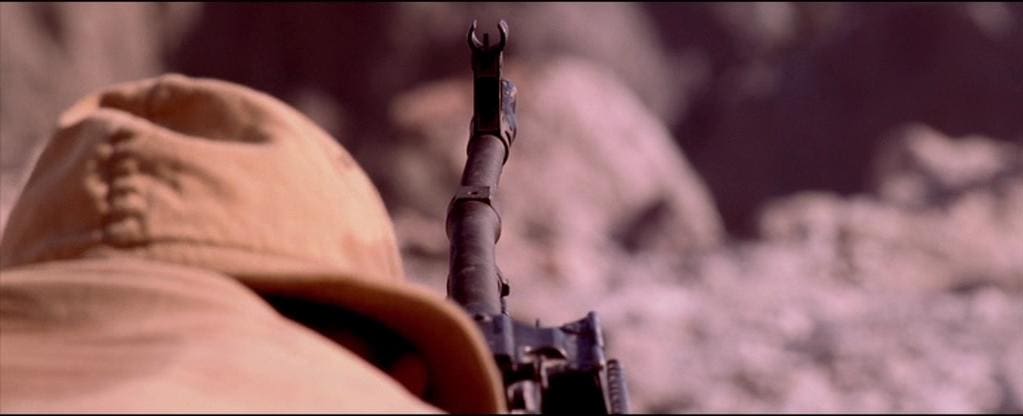
Tim asks:
Nick, I need to aks a question…
I have a scope mounted to my AK47, but it appears I have “bottomed out” the zero adjustments of the scope.
Can you advise on what this means? I have a friend who has a SOCOM with the same problem.
This is a common problem, actually. I’ve done it with too many scopes to remember. And when it happens, thankfully there are some solutions.
The first thing you need to do when you slap a telescopic sight or “scope” on a rifle is zero the scope. I think I sense an “Ask Foghorn” coming on the subject of how to accomplish that, but in the meantime suffice it to say you need to align the point of aim on the scope (the crosshairs) with the point of impact of the rifle (where the bullets hit). The way you do that is by cranking the adjustment knobs on the scope until the two points align for whatever distance you want.
The adjustment knobs in a scope mechanically move some of the components of the optics to make the crosshairs appear to move up, down, left or right. This movement allows you to align the PoA with the PoI while the scope is still firmly attached to the firearm and without breaking out a file.
Most of the time, if everything is more or less aligned, the sighting in process should only take a couple rounds and less than a dozen clicks. The issue arises when the scope is not sufficiently aligned with the bore of the firearm and the scope “bottoms out.”
So what does it mean to “bottom out” the scope? Well, because the scope uses a mechanical mechanism to move the crosshairs around there is naturally a maximum distance that the crosshairs can be moved. This distance is called the “maximum travel” of a scope. Once a scope reaches its maximum travel on the adjustment knobs there is no possible way to make it move any further.
Because this is most typically encountered when distance shooters try and push their equipment past its designed range they say they “bottomed out” the scope when they have traveled as far down as they possibly can (elevated the muzzle as far as possible). But really all it means is that you reached the maximum travel distance for any axis.
Here are some common reasons for why you could have bottomed out a scope, and some possible solutions to that issue.
Problem 1: Unable to Shoot Longer Distances
Like I said, this is the most common form of “bottoming out” a scope.
Let’s say I have an AR-15 rifle that is perfectly sighted in at 50 yards. Like my Pretty Princess is. If I want to make a shot at 1,000 yards, the drop from my initial “zero” position is 54 MoA (~47 feet). If I wanted to adjust for that drop such that my crosshairs would properly align my rifle to make that shot I would need to dial the turrets in my scope down 54 MoA (216 clicks).
The issue here is that my scope, a Trijicon Accupoint, can’t make an adjustment of that size from a typical “level” (compared to the barrel) rail because the maximum travel in any single direction on my scope is about 37 MoA and leaves me 17 MoA short.
There are two solutions to this issue. Solution #1 is to get a scope with a greater travel distance, but on my salary I think that’s a bit of a pipe dream. Solution #2 is the more popular one, and that is to use a scope mount that is slightly slanted compared to the barrel. The most common form of slanted mount is a 20 MoA mount, which tilts the scope down 20 MoA.
I know it’s a crappy picture. Shut up already. But it will help illustrate what I’m talking about.
The reason a slanted mount works is that it alters the angle the scope makes relative to the gun. In order to make a bullet fly further you need to angle the barrel up, increasing the parabola the bullet makes as it flies through the air (well, falls through the air, but whatever). After a certain point the scope bottoms out and is no longer able to match the drop of the bullet.
In the example above, the black solid line indicates the maximum travel of a scope attached to the poorly drawn rifle and the dotted line represents the actual flight path of that round. After a certain distance the scope is no longer able to match the bullet’s trajectory and the shooter cannot make the crosshairs line up with the point of impact.
By adding a slanted scope mount we can buy back some of that mechanical travel by physically changing the angle between the barrel of the gun and the scope. By tilting the scope slightly forwards we are able to hit targets further away than previously possible. The red line in the example above indicates the maximum travel with the slanted scope mount added.
So if I add a 20 MoA slanted scope mount to my rifle I can hit the 1,000 yard target with 3 MoA to spare.
The other solution is to use “holds” instead of actually placing the PoA on the target. A lot of scopes will ship with various markings on the reticle, and if you know how much the space between those markings is (1 MoA, 1 Mil, etc.) you can use those instead of the center of your crosshair.
Problem #2: Unable to Sight In Rifle
Problem 1 assumes that you’ve already sighted in the scope at a known distance. But what about if you can’t sight in the scope at all?
Let’s say for example you’re sighting in an AK-47 variant, but no matter how far you crank the turrets on your scope you just can’t get the PoA to line up with the PoI.
This is an unfortunate problem that I have with a lot of commie milsurp and related stuff. A lot of times the mounts or the barrels will not be installed correctly, and you’ll have a situation where no matter how far you crank your sights (up, down left right, whatever) you can’t get them aligned. Like this poor bastard (9th Company). It’s not something that only commie stuff does, a lot of times you’ll have this same issue on “budget” firearms, but it seems to happen to me more with commie designs than anything else.
The solution to this issue is a little bit harder than the previous one because it will probably require some machining to fix.
In order to be able to zero the gun you will need to get the mount somewhat better aligned with the barrel than the current situation. Imagine if the mount was placed 45 degrees off from the barrel and you were trying to zero the gun — it’s pretty much the same situation. No matter how far you crank that sucker it’s not going to work.
The only situation where you might be able to fix it without breaking out the Dremel is if you’ve bottomed out the scope at the bottom of the optic, but the windage (left and right) is still within the travel of the scope. There’s a good chance that if you try to zero the gun for a longer distance the parabolic trajectory will raise the PoI enough that you can adjust the PoA to match.
If you have a topic you want to see covered in a future “Ask Foghorn” segment, email guntruth@me.com.
To browse previous Ask Foghorn segments visit http://www.thetruthaboutguns.com/category/askfoghorn/.






Thanks, Nick – that explains the issue. My scope is OK for windage, so perhaps I can shim the elevation a bit.
Did Tim really need to aks a question?
This isn’t the kind of article to incite lots of commentary, but I just wanted to say thanks for doing them. I’ve learned a lot from this blog in general, and from the Ask Foghorn articles specifically.
Thanks, that really means a lot!
That’s the reason why I get nervous every time I see a comment on one of these articles. My first thought is always “oh shit, what did I screw up…”
I second that. I’m still relatively new to firearms, so these articles have been very helpful.
Seems like for case #2 it could be pretty hard to track down the cause (especially if you don’t have anything else to compare it to).
Maybe a bit off topic,
The one shot “scope” zero,
Using a bench rest [or something to stabilize the rifle] looking down through the barrel center on target, looking through the scope adjust to center on target aka [bore sighting] when complete, take your best shot aiming at center of target using the bench rest [I like to use 25m for this set up] after your shot [ensure rifle is unloaded] secure the rifle to the bench rest with the cross hairs on the “bullet strike” [its important that the rifle does not move during this part] slowly adjust the cross hairs back to target center [without moving the rifle] you have just zeroed with one shot!
One variable;
Ensure that the rifle is level right to left [canted] for both the shot and adjustments [this is very important when shooting long range].
BTW I won a few bets at a local shot doing this, the guys thought it was amazing how easy it was to do! Good shooting all and…
Knowledge is Power, Practiced Knowledge is Strength, Tested Knowledge is Confidence
“The reason a slanted mount works is that it alters the angle the scope makes relative to the gun.”
so that’s what the (discontinued) Rossi single shot 7.62×39 has..didn’t know “slanted mount” existed.
But wait… if the swing from a 50-yd zero to a 1000-yd zero is 54MOA, why aren’t all (most) scope mounts (20-25 MOA or whatever half the maximum delta is for a typical scope) slanted? Sure, you could “top out” your scope trying to zero for less than 50 yards – but who needs a scope for that? Shouldn’t the down-slant be such that the scope is “parallel” to the barrel when it’s topped out (or close to it)? I suppose there’s always the case of having to shoot steeply up/down hill at very short distances (45 degrees up at 25 yards anyone?), but for the majority of shooters, I’d expect the ability to dial-in longer ranges would trump the edge cases ( Sub-50 yard shots at extreme angles? Shooting on the vomit-comet? Hunting in space?)
Just thinking out loud here.
Very helpful on how to think about scope limitations and adjustments. And while yes, the pic above is crappy it does get the point across
We used to put paper in the bottom of the rear scope mount to add elevation. Some times quite a few layers. Depended on the scope, mount, and range desired.
Paragraph writing is also a fun, if you know then you can write
or else it is complex to write.
So if ur using a 20 Mia mount the cross hairs will be in the lower half of ur scope , not the center ?
Comments are closed.